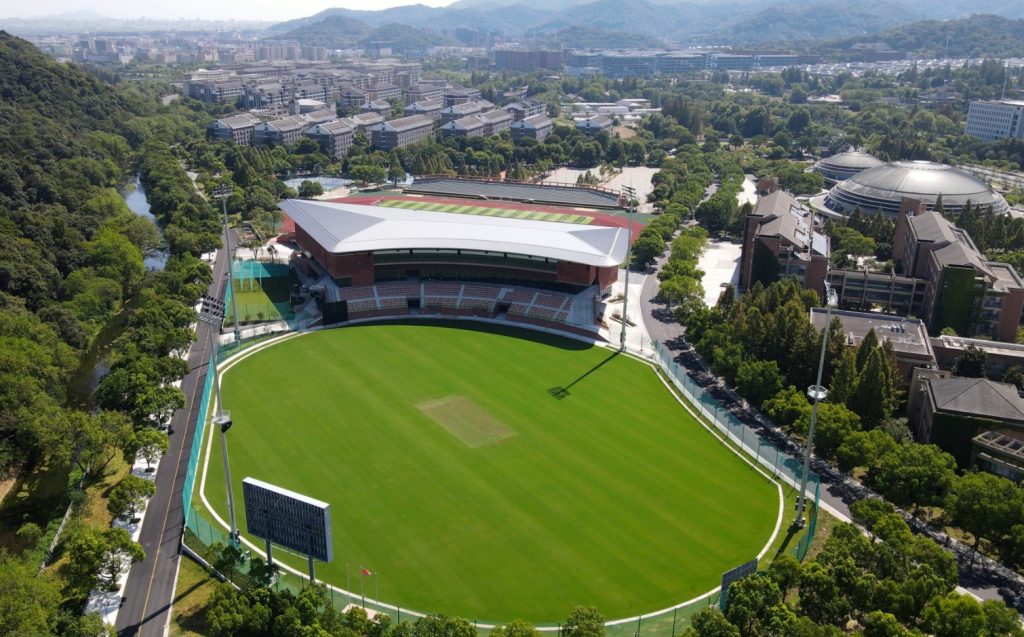Hangzhou Cricket Stadium: The rise of cricket in non-traditional countries has seen new venues make their way onto the international stage. Among these, Hangzhou Cricket Stadium, officially known as the Zhejiang University of Technology Cricket Field, became a focal point during the 2023 Asian Games held in China. As cricket grows in East Asia, stadiums like this play a key role in shaping the future of the sport in the region.
Table of Contents
Hangzhou Cricket StadiumA crucial element of any cricket ground is its boundary length, which directly affects scoring, strategies, and even the outcome of games. In this article, we’ll take an in-depth look at the boundary dimensions of the Hangzhou Cricket Stadium, analyze its effect on gameplay, and compare it with other international venues.
Introduction to Hangzhou Cricket Stadium
Located on the Pingfeng Campus of Zhejiang University of Technology, the Hangzhou Cricket Stadium is a compact, modern venue designed specifically to meet the needs of growing cricket enthusiasm in China. Built to international standards, the stadium made headlines during the 2023 Asian Games where cricket was one of the featured sports.
Though cricket in China is still developing, this venue signals ambition—offering top-tier infrastructure, a lush green outfield, and a pitch that provides fair balance to both bat and ball. However, one of the more talked-about features during the Asian Games was its short boundary dimensions, which encouraged aggressive play and record-breaking performances.
Boundary Length of Hangzhou Cricket Stadium
Unlike some of the larger and more established grounds in traditional cricketing nations, the boundaries at Hangzhou are relatively short, especially square of the wicket. This leads to high-scoring matches and makes six-hitting more common—even among teams new to international cricket.
Here’s a breakdown of the boundary measurements in meters:
| Boundary Area | Length (Meters) |
|---|---|
| Straight Boundary | 68 |
| Square Boundary | 63 – 65 |
| Fine Leg Boundary | 55 |
| Third Man Boundary | 55 |
Notes:
- Straight boundaries are modest but not overly short—offering a fair challenge for six-hitting down the ground.
- Square boundaries, ranging around 63–65 meters, give batters a strong incentive to target midwicket and point.
- Fine leg and third man boundaries are tight at around 55 meters—especially favorable for sweep shots and late cuts.
How the Shorter Boundaries Influence Play
🔸 Batting Strategies
- Players are more willing to take aerial risks knowing that clearing the rope is easier, especially for shots like the pull or the slog sweep.
- Batsmen favor unorthodox shots—reverse sweeps, scoops, and switch hits—because they can easily reach or beat the boundary behind the wicket.
- Left-handers and right-handers target the leg-side boundary based on the angle of the bowler, manipulating the field effectively.
🔹 Bowling Adjustments
- Bowlers need pinpoint control. Anything short or wide is punished with ease due to the tight boundaries.
- Yorkers and slower deliveries become more critical tools to prevent big hits.
- Spin bowlers, in particular, need to use the width of the crease and flight to force errors rather than rely on containment.
🔸 Fielding Implications
- Fielders near the ropes are under constant pressure, especially during T20 games.
- Strategic placement becomes vital to prevent boundaries and cut off angles.
- Boundary riders must be quick on their feet and agile to cut down what would otherwise be easy fours.
Comparison With Other International Grounds
To understand how unique the Hangzhou Cricket Stadium is in terms of dimensions, let’s compare it with some globally recognized cricket venues:
| Stadium | Straight (m) | Square (m) | Avg. Boundary Size |
|---|---|---|---|
| Hangzhou Cricket Stadium | 68 | 63–65 | Short |
| Melbourne Cricket Ground (MCG) | 75–80 | 70–75 | Large |
| Dubai International Stadium | 70–75 | 68–70 | Medium |
| Eden Gardens, Kolkata | 70–75 | 65–70 | Medium-Large |
| Wankhede Stadium, Mumbai | 60–65 | 60–65 | Short |
From this table, it’s clear that Hangzhou’s ground is on the smaller end, even compared to subcontinental venues like Wankhede. This naturally leads to more explosive matches, especially in the T20 format.
Real-World Impact: Records at Hangzhou
During the 2023 Asian Games, the impact of the stadium’s dimensions was immediately evident:
- Nepal’s team posted a record-breaking 314/3 in a T20I against Mongolia.
- Kushal Malla scored a blistering 137 off 50 balls, one of the fastest T20 centuries ever.
- A total of 26 sixes were hit in that match, many of which cleared the square boundary with ease.
Small Size, Big Impact
The boundary length of Hangzhou Cricket Stadium is not just a number—it’s a defining characteristic of the venue. With square boundaries around 63–65 meters and shorter fine leg/third man boundaries at 55 meters, the ground clearly favors high-octane, aggressive cricket.
While some purists may argue that shorter boundaries tip the balance too far in favor of the batsman, there’s no denying the entertainment value and excitement it brings—especially in formats like T20. As cricket continues to grow in China and East Asia, venues like this one offer the perfect stage for thrilling encounters and help introduce the game to a new generation of fans.
For players, coaches, and analysts, understanding the ground’s dimensions is essential. And for fans, it means one thing: expect fireworks when a match is played at Hangzhou Cricket Stadium.


